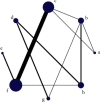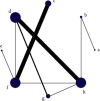Network Meta-Analysis of the Safety of Drug Therapy for Cardiogenic Shock
- PMID: 32802302
- PMCID: PMC7416258
- DOI: 10.1155/2020/8862256
Network Meta-Analysis of the Safety of Drug Therapy for Cardiogenic Shock
Abstract
Objectives: (1) To conduct a network meta-analysis of clinical drugs used for cardiogenic shock and (2) provide evidence for the selection of medication for the treatment of this condition.
Methods: PubMed, EMBASE, Cochrane library, China HowNet (CNKI), Wanfang database, and Weipu database were searched using keywords Dopamine, Dobutamine, Epinephrine, Adrenaline, Norepinephrine, Noradrenaline, Milrinone, Natriuretic peptide, Recombinant human brain natriuretic peptide, Levosimendan, Cardiac shock, and Cardiogenic shock. We select literature according to prespecified inclusion and exclusion criteria and record data such as drug type, mortality, and adverse reactions.
Results: Twenty-eight of 1387 articles met inclusion criteria, comprising 1806 patients who suffered from cardiogenic shock. Dopamine, dobutamine, epinephrine, norepinephrine, milrinone, recombinant human brain natriuretic peptide, and levosimendan were all commonly used in the treatment of cardiogenic shock. Milrinone was most effective at reducing mortality and had the lowest incidence of adverse reactions.
Conclusion: This network meta-analysis demonstrated that milrinone was the most effective medication at reducing mortality and adverse events in patients suffering from cardiogenic shock.
Copyright © 2020 Xianyong Liao et al.
Conflict of interest statement
The authors declare that there are no conflicts of interest regarding the publication of this paper.
Figures





Similar articles
-
Inotropic agents and vasodilator strategies for the treatment of cardiogenic shock or low cardiac output syndrome.Cochrane Database Syst Rev. 2020 Nov 5;11(11):CD009669. doi: 10.1002/14651858.CD009669.pub4. Cochrane Database Syst Rev. 2020. PMID: 33152122 Free PMC article.
-
Comparison of norepinephrine-dobutamine to epinephrine for hemodynamics, lactate metabolism, and organ function variables in cardiogenic shock. A prospective, randomized pilot study.Crit Care Med. 2011 Mar;39(3):450-5. doi: 10.1097/CCM.0b013e3181ffe0eb. Crit Care Med. 2011. PMID: 21037469 Clinical Trial.
-
Cardiology update. Drug therapy.Nurs Stand. 1993 Nov 10-16;8(8):52. Nurs Stand. 1993. PMID: 8260421 No abstract available.
-
Comparative Effectiveness and Safety Between Milrinone or Dobutamine as Initial Inotrope Therapy in Cardiogenic Shock.J Cardiovasc Pharmacol Ther. 2019 Mar;24(2):130-138. doi: 10.1177/1074248418797357. Epub 2018 Sep 2. J Cardiovasc Pharmacol Ther. 2019. PMID: 30175599
-
Meta-analysis Comparing the Efficacy of Dobutamine Versus Milrinone in Acute Decompensated Heart Failure and Cardiogenic Shock.Curr Probl Cardiol. 2023 Aug;48(8):101245. doi: 10.1016/j.cpcardiol.2022.101245. Epub 2022 May 8. Curr Probl Cardiol. 2023. PMID: 35545181 Review.
Cited by
-
Levosimendan in intensive care and emergency medicine: literature update and expert recommendations for optimal efficacy and safety.J Anesth Analg Crit Care. 2022 Jan 24;2(1):4. doi: 10.1186/s44158-021-00030-7. J Anesth Analg Crit Care. 2022. PMID: 37386589 Free PMC article. Review.
-
Inotropic support in cardiogenic shock: who leads the battle, milrinone or dobutamine?Ann Med Surg (Lond). 2022 Sep 22;82:104763. doi: 10.1016/j.amsu.2022.104763. eCollection 2022 Oct. Ann Med Surg (Lond). 2022. PMID: 36268289 Free PMC article. Review.
References
-
- Chen W., Zhao L., Li L., et al. Predictive value of extravascular pulmonary water index and cardiac index on the prognosis of patients with cardiogenic shock. Chinese Journal of Circulation. 2014;37(11):895–898.
-
- Zhang S. Progress in diagnosis and treatment of cardiogenic shock and interpretation of guidelines. Journal of Medical Research. 2017;46(478):7–9.
-
- Huang C. Guidelines for cardiovascular emergency management—acute myocardial infarction complicated with cardiogenic shock. Chinese Journal of Practical Internal Medicine. 2000;20(9):515–517.
-
- Jing S., Zhang X., Lu J. Efficacy of milrinone in the treatment of heart failure after acute myocardial infarction. Journal of Kunming Medical College. 2010;31(8):134–136.
Publication types
MeSH terms
Substances
LinkOut - more resources
Full Text Sources
Medical
Miscellaneous

